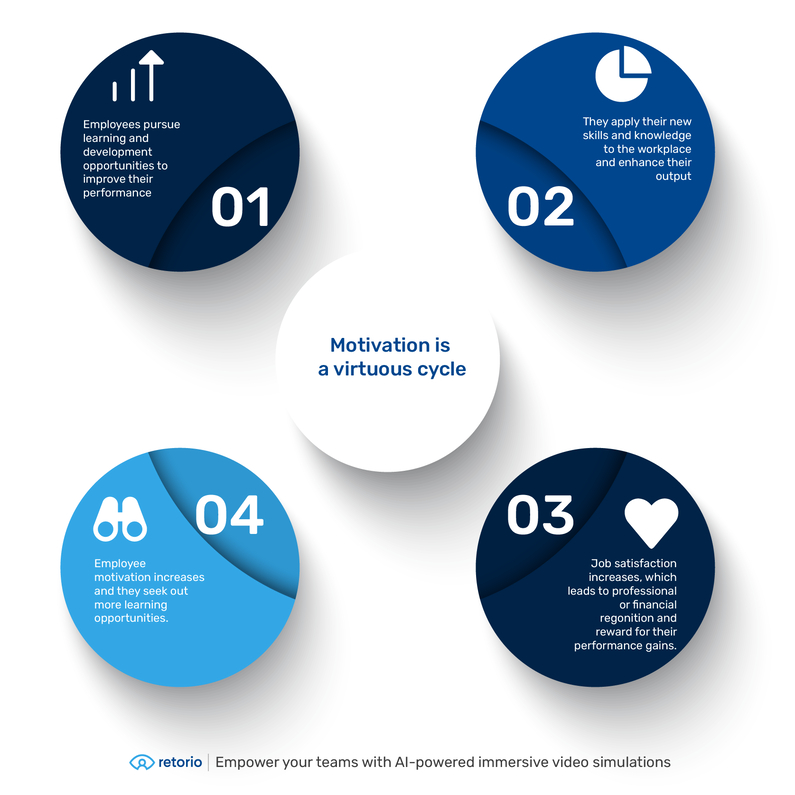We have all been there: walking into a boardroom mentally preparing ourselves for a lengthy, uninteresting conference about a subject already taught last year, all while stressing out about the pile of work growing on our desks as we listen to the instructor drone on.
Training is meant to bring about employee productivity and motivation, and holding a three-day conference will not always benefit your organization's employee engagement rate. Therefore, knowing how to create training that excites employees is the key to increasing employee satisfaction and business success.
This blog post will delve into the six ways you can boost your motivation training and get employees motivated to learn new skills that will be well-invested for a successful career.
What's in this post:
What is motivation training?
Motivation training is a program that takes place inside an organization aiming to increase and maintain an employee's motivation levels, dedication, and desire to reach professional goals and successfully contribute to the company's success.
Motivation training typically consists of a combination of motivational techniques used to enhance employee training performance. Some examples of motivational techniques can include the following:
-
Offering employees personal enrichment programs by sending them to workshops or encouraging them to participate in activities and trainings where they can improve their skills
-
Recognizing and validating their good work to show them appreciation for their contributions to the company. Showing employees that you see how hard they worked, can help them become motivated to improve further on their performance.
-
Building more positivity and trust within teams will increase happiness in the workplace which boosts productivity.
-
Encouraging more mindfulness
Motivation training essentially involves psychological and emotional factors that will inspire employees to actively engage in, learn from, and develop their skills and knowledge as part of the training program.
What impact does motivation training have on employee performance?
Did you know that an unmotivated employee can cost businesses up to $550 billion a year? This is because when an employee is not aligned with the company's goals and vision, they are neither motivated to share innovative ideas nor are they likely to perform well.
Therefore, by implementing a motivation training course into your company's L&D program, employees become more motivated to fully engage in their training schedule, participate actively in team events, and take on higher responsibility for their learning. Of course, motivation is not the only driver for top performance, but it is certainly a key element of it.
Employees who are motivated are higher-performing employees. They approach training with more enthusiasm and are keen to learn new knowledge and skills that will help them improve their work performance and meet their goals. This degree of engagement and excitement translates into higher retention rates, lower turnover rates, and enhanced skill application in the workplace.
Moreover, employees who are motivated to invest in their professional growth become more competent and confident with the different aspects of their jobs. They become better equipped to overcome challenges and obstacles efficiently and contribute to the organization's goals which leads to higher job satisfaction.
Organizations that frequently invest in employee motivation training gain a 27% increase in their profits. This is in addition to a 50% rise in sales, a 38% increase in productivity, and a 50% increase in customer loyalty.
Below is a table showing the impact of motivation training for employees in correspondence with employer benefits:
| Benefits for employees | Corresponding benefits for employers |
|
Enhances an employee's understanding of job roles and what is expected of them from their manager and supervisors.
|
Facilitates streamlined operations which result in improved effectiveness, and enhanced performance management.
|
|
Gain more skills and expertise about their job, the company, and the market.
|
Adapts quickly to evolving market trends and organizational needs.
|
|
Elevated skill sets and competencies.
|
Enhances the economic efficiency and the quality of work and other outcomes.
|
|
Improved productivity, boosted morale, and enhanced engagement levels.
|
Builds greater commitment to organizational objectives, reduces absenteeism and turnover rates, and enhances the quality and economics of output.
|
This goes to show that the investment you make for your greatest assets (your employees), is the investment you make for organizational success.
What role does L&D play in motivating and retaining employees?
Learning and Development is vital to help maintain motivation within teams and build emotional intelligence.
Statistics have revealed that a whopping 41% of employees quit their company due to the lack of development opportunities for their careers. As mentioned before, employees are assets that drive organizational success, thus it's vital to have motivated staff that is ready to reach for that success than one that isn't.
Leaders must invest in the workforce through L&D programs in the same way that they do in other long-term assets such as maintenance, restorations, or refurbishments. Your employees are the key to gaining loyal customers and improving your brand image.

How to boost motivation training in employees
The average employee does not simply take advantage of learning opportunities simply because they are available at work. It might take a little more than that to get them convinced, and this is all part of motivation training in employees.
There is statistical evidence from the Udemy Academy Survey that states that the correlation between employee performance and the motivation to learn is between these four distinct characteristics:
-
Their desire to improve, professionally and personally (45%).
-
They need to catch up on their skills to gain a better understanding of their job (31%).
-
External factors over which they have no control (8%).
-
A constant yearning for development (6%).
However, the biggest percentage lies in an employee's own dedication. So how can you boost your employee's motivation during their training, and get the performance results you've been waiting for? Let's dive right in.

Understand what motivates your employees
When it comes to motivating people to do something, especially training, remember that everyone has their own motivator, something that drives them to want to perform their best and learn new skills. However, many managers make the mistake of approaching training programs with a one-size-fits-all mindset.
Ask your employees what they need to do their job better, where they would like to see more learning opportunities (for career development), and what might make their work life easier and more satisfying.
Gaining a deeper understanding of what motivates your employees is crucial in knowing how you can get them to take part in more training and genuinely enjoy the learning process.
Make training a part of your company culture
One of the practical strategies that you can use to boost motivation training is making training and learning part of your company culture.
With that being said, think about the last time that you, as the manager, took part in a training program. Make time to demonstrate your dedication to employee engagement and motivation by participating in a training program.
By doing this, you can put yourself in your employee's shoes to see why they may struggle to stay motivated and engaged during training and identify ways to improve it. If the training is boring you, it is definitely more boring for your staff.
Therefore, you as a leader can lead by example by actively participating and advocating for training programs and promoting an attitude for continuous development among all levels of your employees.
Make your training attractive through personalized training
One of the biggest demotivators when it comes to a training program is when employees have either 1. already been through the exact same material before, 2. it does not fit their learning style and pace, or 3. the training program does not cover their skills gaps and is more generalized.
When a training program is catered towards each employee directly by providing recommended exercises to them based on their strengths and areas of improvement, it can help your employees feel more motivated to take part in a comprehensive course.
You can create a more personalized training experience by conducting a training needs analysis to identify which type of training each employee needs in order to thrive in their role, and fill in knowledge gaps to improve their performance.
Personalized training should:
-
Identify the strengths and areas of improvement of each employee.
-
Provide personalized, recommended exercises that will help them nurture their strengths and improve on their weaknesses.
-
Provide tailored feedback based on their performance.
Integrate social learning and gamification strategies
Social learning is a powerful way to enhance your employee's learning experience. It involves learning with and from others through interactions, activities, collaboration, and feedback sessions.
Oftentimes, training courses are a solo activity. Therefore, when looking for ways to boost motivation training, try incorporating engagement into the programs to keep employees inquisitive and focused. Social learning can also motivate employees if they are able to interact with other employees and exchange ideas. More importantly - it builds a sense of community when employees get to learn new skills together, engage in knowledge-sharing, and share their backgrounds, goals, and interests.
Social learning can also include gamification by adding fun, challenge, competition, and feedback to enhance motivation and engagement. Gamification strategies such as collecting points, badges, levels, and leaderboards can be used to create social learning activities that are appealing to your employees.
You can also utilize incentives such as certifications, badges, or prizes to acknowledge and honor their accomplishments and participation in training. All in all, gamification can make training programs more enjoyable for employees.
Provide ongoing feedback
To keep an employee motivated is to keep employees engaged. When it comes to motivation training, giving regular feedback to employees will help them to stay on track with their goals, and be accountable for their progress.
As a leader, giving feedback to your team will let them know that you care about their professional development, and are monitoring their job performance. You can establish regular communication channels such as regular one-on-one feedback sessions to discuss training progress and use that time to address any concerns or questions that come up.
When giving constructive feedback, focus on recognizing the achievements of each employee and provide guidance for further development. Take this opportunity to emphasize the importance of training and how it can align with their career growth.
You should also actively listen to the feedback that employees give to ensure that the training courses are responding to their learning needs and preferences. This ongoing feedback will provide your company with valuable insights into their L&D program, and also indicates your commitment to the growth of employees, eventually increasing motivation and involvement in training activities.
Reward your employees
A Harvard Business Review study found that companies that make provisions for motivation training have motivated 66% of their employees to not quit and stay with the company longer.
This included providing employees with the right incentives such as recognizing and rewarding their achievements and hard work, praising them publicly, and diversifying awards.
Additionally, companies that offer other rewards such as bonuses, compensation increases, or additional work benefits for successful completion of training milestones. It also shows your appreciation for an employee's efforts in developing their skills to become better performers and contribute more to the company's success.
Companies that take time to recognize and reward employees' dedication to training not only raise motivation but also help companies promote the significance of continuous learning and improvement.
What is a strength-based training culture?
A strength-based culture is exactly what it may sound like. It is a culture in which talking about workplace strengths is regular and productive, shaping people's perspectives and approaches to work.
Leaders, managers, and employees in a strength-based culture choose to consistently develop each person's potential, resulting in an engaged, and motivated workforce that fosters organic corporate growth. In other words, a strength-based approach aims to help employees identify their strong suits and improve on them in alignment with organizational goals.
According to Gallup, the benefit gained from implementing strength-based training will result in the following:
-
An increase in employee engagement by 7% to 23%.
-
Improves work performance by 8% to 18%.
-
Boosts team productivity by 17%.
-
Lower attrition by 20% to 73%.
-
Increases profitability by 21%.
This form of training culture puts your employee's strengths at the core and creates a company culture that focuses on continuous growth and improvement, and provides personalized learning opportunities for your team.
Benefits of motivation training
A study by Gallup reveals that motivated employees are more likely to consistently look for ways to improve their progress and productivity and assist overloaded coworkers to ensure efficiency. Therefore, motivated employees are 20% more efficient in their tasks and responsibilities.
In addition to heightened productivity amongst motivated workers, motivated employees hold a stronger emotional attachment to their company, making them less inclined to quit for another opportunity.
A survey of over 50,000 employees indicated that motivated employees are 87% less likely to leave a firm. When compared to employees who are not motivated or engaged, they are a dozen times less likely to churn.
Another Gallup survey found that adequate employee motivation in a workplace enhances job retention.
Teams that are highly engaged and motivated have 41% fewer absenteeism and a 17% increase in performance output.
Here are some other key benefits of motivation training:
-
Increased employee engagement: When employees are motivated to participate in training programs, they become more engaged in their development journey and responsibilities. They actively seek out opportunities to learn and develop new skills, which leads to an increased level of commitment and interest in the company. Employees who are engaged are also more likely to easily retain information, and successfully apply their knowledge in the workplace.
-
Improved performance and productivity: Employees who are motivated are more inclined to strive for excellence and continuously improve their performance.
-
Enhanced job satisfaction and retention: Motivation training contributes to higher job satisfaction among employees. Employees who feel supported in their professional development and are given the opportunity to develop new skills and knowledge experience a sense of fulfillment in their careers and are more likely to stay with the company that invests in their growth. This leads to improved job loyalty and lower turnover rates.
-
Building a positive learning culture: Motivation training contributes to the organization's culture of continuous learning and improvement. Motivated employees create a knock-on effect, motivating others to participate in training programs and seek development opportunities. Having a motivated, positive learning culture puts the company in a strong position to prosper in the ever-changing business landscape.
-
Attract top talents: Companies that prioritize motivation training for employee development and training have a more competitive edge when it comes to attracting top talent and building a strong candidate pool. Job seekers are constantly searching for professional advancement opportunities. Therefore, organizations will be more likely to recruit highly skilled employees who are driven to achieve and contribute to the organization's success through motivation training and showing their commitment to an employee's learning path.
Are you searching for training programs that actually work? Retorio's AI Coaching platform has got you covered. Retorio's AI-powered training platform provides every individual with personalized training programs and real-time feedback that is tailored to each individual's performance.
What's more, Retorio's training program offers video-AI role-play simulations that immerse you in several real-life workplace conversations and challenges that you may deal with on a daily basis.
.webp?width=3576&height=1843&name=Retorio%206%20Ways%20To%20Boost%20Motivation%20Training%20In%20Employees%204%20(1).webp)
Boost your motivation training and the motivation of your employees by implementing training that will prepare people for what actually matters. Help them to build self-awareness and confidence in no time and retain your top talent easily and efficiently.
Click on the button below and see how easy it can be!
FAQ
Motivation is the degree of drive, passion, and enthusiasm that a company's employees bring to their jobs every day. Without motivation, firms will begin to experience decreased productivity which leads to lower levels of production, and a dip in work performance. As a result, companies will most likely fall short in meeting organizational objectives if their staff is unmotivated to develop their skills to become more efficient in their work.
Think about what motivates you to show up to work and do your best. Your employees may be thinking something similar. Of course, money and additional corporate benefits are vital in keeping employee motivation high. However, a recent study found that the biggest motivational factors for employees consist of a good work-life balance (21%), peer motivation (20%), and a leader who is encouraging and motivated (15%).



